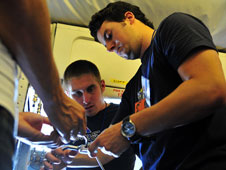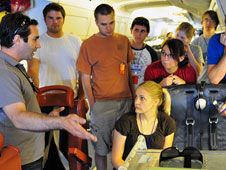
Student Airborne Research Program environmental science students Eric Kauffman from Stephen F. Austin State University (left) and Clayton Elder from Oklahoma State University (right) bend tubing to complete the installation of the Whole Air Sampler onboard NASA’s DC-8 airborne science laboratory. Students will collect samples over the Los Angeles basin and California’s Central Valley to measure air pollution. (NSERC / Jane Peterson) PALMDALE, Calif. – Twenty-nine undergraduate and graduate students are participating in a six-week NASA Airborne Science Program field experience designed to immerse them in the agency’s Earth Science research. The students represent 28 colleges and universities from across the United States. NASA’s Student Airborne Research Program provides a unique opportunity for undergraduates and early graduate students majoring in the sciences, mathematics and engineering to participate in all aspects of a NASA airborne research campaign. Students fly aboard NASA’s DC-8 aircraft, assisting in the operation of instruments on board the aircraft to sample atmospheric gases, image land and water surfaces and take measurements at field sites.
The program began June 19 at the University of California, Irvine, with lectures by university faculty members, NASA scientists and NASA program managers. Students are divided into three groups to study air pollution in the Los Angeles basin, orchards in California’s Central Valley, and the distribution and abundance of giant kelp in the Santa Barbara Channel.
Aboard the DC-8 flying laboratory, which is based at NASA’s Dryden Aircraft Operations Facility in Palmdale, Calif., students in the program are given a rare behind-the-scenes look at the instrument integration, flight planning and payload testing that is the basis of every successful Earth Science airborne campaign carried out by NASA. These campaigns play a pivotal role in the calibration and validation of NASA’s space-borne Earth observations, remote sensing measurements and high-resolution imagery for Earth system science.
This week, students will make three flights on the DC-8, departing from NASA’s Palmdale facility. During the flights, the aircraft will travel north over almond and pistachio orchards, vineyards and dairies in the San Joaquin Valley at altitudes as low as 1,000 feet above the ground, fly over the Santa Barbara Channel to study giant kelp beds, and fly over water treatment plants in the Los Angeles Basin to study air pollution.

Dr. Nick Clinton of UC Santa Cruz and NASA’s Ames Research Center outlines the functions of the MODIS/ASTER airborne simulator, or MASTER, instrument to students participating in the 2011 Student Airborne Research Program. The students will use the MASTER to collect remote sensing data that will be used to measure the abundance and distribution of giant kelp in the Santa Barbara channel and to measure evapo-transpiration from almond orchards in California’s Central Valley. (NSERC / Jane Peterson) The Student Airborne Research Program is one of NASA’s tools for training future scientists for Earth Science missions that support environmental studies and the testing and development of new instruments and future satellite mission concepts. The program’s goal is to stimulate interest in NASA’s Earth Science research and aid in the recruitment of the next generation of scientists and engineers.
The program is managed through the National Suborbital Education and Research Center at the University of North Dakota with funding and support from NASA’s Airborne Science program. The center was established through a cooperative agreement between the University of North Dakota and NASA.
For additional information about NASA’s DC-8, visit:
https://www.nasa.gov/centers/dryden/aircraft/DC-8/index.html
For more information about the Airborne Science Program, visit:
http://airbornescience.nasa.gov
For additional information about the National Suborbital Education and Research Center at the University of North Dakota, visit:
http://www.nserc.und.edu
– end –
text-only version of this release
To receive status reports and news releases issued from the Dryden Newsroom electronically, send a blank e-mail message to dfrc-subscribe@newsletters.nasa.gov. To unsubscribe, send a blank e-mail message to dfrc-unsubscribe@newsletters.nasa.gov. The system will confirm your request via e-mail.
Leslie Williams
Dryden Flight Research Center
661-276-7960
emily.schaller@nasa.gov




























